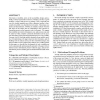Free Online Productivity Tools
i2Speak
i2Symbol
i2OCR
iTex2Img
iWeb2Print
iWeb2Shot
i2Type
iPdf2Split
iPdf2Merge
i2Bopomofo
i2Arabic
i2Style
i2Image
i2PDF
iLatex2Rtf
Sci2ools
ASSETS
2004
ACM
2004
ACM
Middleware to expand context and preview in hypertext
Movement, or mobility, is key to the accessibility, design, and usability of many hypermedia resources (websites); and key to good mobility is context and preview by probing. This is especially the case for visually impaired users when a hypertext anchor is inaccurately described or is described out of context. This means confusion and disorientation. Mobility is similarly reduced when the link target of the anchor has no relationship to the expected information present on the hypertext node (web-page). We suggest that confident movement with purpose, ease, and accuracy can only be achieved when complete contextual information and an accurate description of the proposed destination (preview) are available. Our past work (1) deriving mobility heuristics from mobility models, (2) transforming web-pages based on these heuristics, and (3) building tools to analyse and access these transformed pages; has shown us that a tool to expand context and preview would be useful. In this paper we ...
| Added | 30 Jun 2010 |
| Updated | 30 Jun 2010 |
| Type | Conference |
| Year | 2004 |
| Where | ASSETS |
| Authors | Simon Harper, Carole A. Goble, Robert Stevens, Yeliz Yesilada |
Comments (0)

